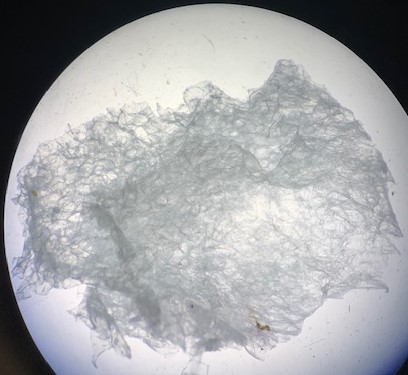
Referring back to this microscopic image of the freeze dried material I took at CMBD.
The freeze dried matrix looks similar to the microscopy of Pelling Lab’s apple and microscopy of Vacanti’s ear mouse (image below). The Vacanti mouse has proved inspirational to several artists working with wet biology including Tissue Culture and Art Project, Stelarc and myself. The Ear Mouse has informed my chimeric interfaces including; Chimera series (2001), Blood flowers (2003), Man A Plant (2006), Matrix (2016) and The Colonised Body (2016).
(above) ‘Polyglycolic acid polymer seeded with dissociated cells.’ Vacanti’s ear mouse (Forkus Brittany, Ear on a Mouse, OpenWetWare.org)
“One of the pivotal considerations in the design of this polymer scaffold for the engineering of replacement tissues is in regards to the selection of an appropriate matrix material. This ideal scaffolding material would need to have several essential characteristics and tuning capabilities for proper functionality in this application for it must be–biocompatible, mechanically stable, flexible, controllably degradable, resorbable, and capable of making specific chemical interactions with the seeded cells. In terms of biocompatibility, it is essential that the polymer avoids eliciting an undesired immune response in the host which could ultimately result in immune rejection and procedural failure. Physically, the matrix needs to have a certain degree of mechanical stability and flexibility to ensure that it can provide the necessary support and space for tissue formation, so that it can be easily designed and constructed into variable shapes and structure, and it must be able to withstand the procedure and in vivo environment in order to maintain this structure upon implantation. Finally, some desirable tuning capabilities of the ideal polymer scaffold would entail tunable degradation characteristics, the matrix should be capable of resorbing to the body while leaving only natural, functional tissue, and the manipulation of surface chemistry to dictate desired interactions between the seeded cells and the matrix surface.’ (Forkus Brittany, Ear on a Mouse, OpenWetWare.org)
The Pelling Lab apple and the Vacanti mouse matrices are both layered with collagen for cells to adhere to. Perhaps collagen can be swapped out for seaweed alginate if biocompatable.
